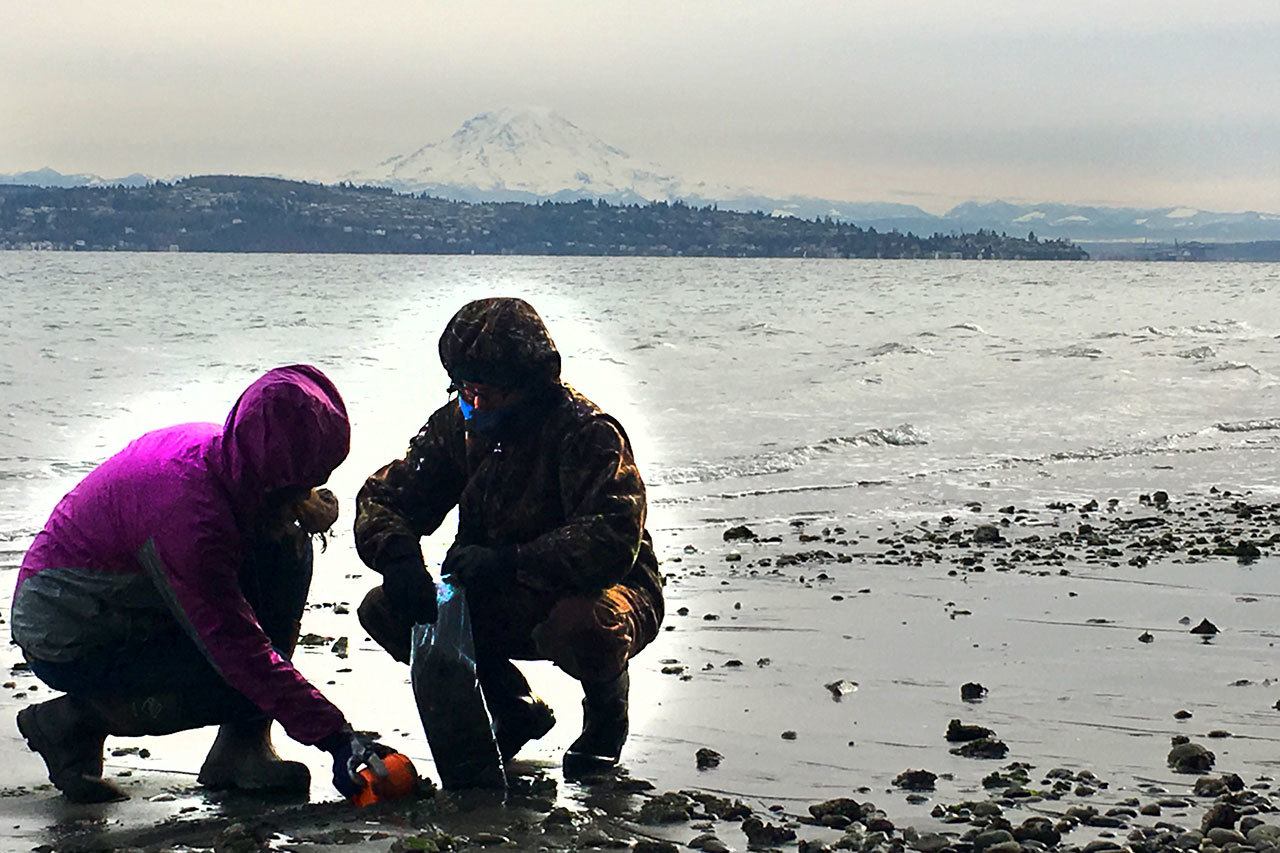On several cold, wet nights this winter, while most islanders cozied up by the fire, a group of intrepid scientists and volunteers visited local beaches to pan for gold of a different variety — fish.
The volunteers were looking specifically for forage fish, which are more valuable to the island’s habitat than gold. They carefully measured out predetermined beach sections, then used modified gold-panning equipment to sift the fish eggs out of their sandy beds. These samples were sent to a Department of Natural Resources lab where researchers will determine and report back the numbers and kinds of forage fish found.
Each beach was chosen for contrasting characteristics to give scientists information about what makes a healthy fish habitat.
The effort is one part of the island Beach Watcher Program, a citizen-science partnership of Vashon Nature Center, Vashon-Maury Island Land Trust, Washington Department of Natural Resources, King County and the University of Washington.
“These fish are important and are called forage fish for a reason: They are foraged,” Bianca Perla, director of Vashon Nature Center, said. “They are the underpinning the whole food web and are supposed to be very abundant. Their existence is critical to salmon and sea birds.”
The Beach Watcher Program focuses specifically on sand lance and surf smelt; though herring are also key forage fish, they spawn in deeper waters so egg abundance can’t be measured using the panning method.
This beach spawning is a critical part of the forage-fish life cycle. During a high-tide, the fish swim together in a frenzied mass to deposit the female’s eggs and male’s milt. These free-floating gametes somehow find each other and join before falling to the sediment where they will develop over the next several weeks. The tide then recedes, leaving the newly fertilized eggs exposed and vulnerable.
“We’re focusing on this part of the life cycle because we’re losing so many natural beaches,” Perla said. “We’re losing a lot of sand due to bulkheading and shoreline development. This also eliminates trees and other overhanging vegetation, which shades the eggs and keep them from drying out.”
Tom Dean, executive director of the Vashon-Maury Island Land Trust, said that shoreline development and bulkheads prevent the natural erosion of beaches which is actually necessary for healthy shorelines.
“Since the Dust Bowl, we have all been trained to fear erosion, so to turn around and tell people erosion is good for our shorelines is difficult to get across,” Dean said about selling the idea of bulkhead removal to landowners. “For years, we’ve had lots of efforts to teach about animals found on the beach, and now it’s time to go the next step to: ‘What am I seeing in the physical landscape and what does that mean for the health of beach creatures?’”
Together with King County’s Greg Rabourn, an effort is underway to remove bulkheads and armoring to restore the health of the sound and, specifically, salmon. Data collected on Vashon will contribute to a Puget Sound research study spearheaded by Jason Toft at the University of Washington School of Aquatic and Fishery Sciences.
Though they serve as lynchpins of the entire food web, researchers know very little about forage fish. That’s where the Beach Watcher Program comes in. Examining different habitat characteristics that provide good egg-rearing conditions side-by-side will help define the perfect conditions under which these fish thrive. The Vashon study compares stretches of contiguous shoreline that include three types of beaches: untouched shoreline, shoreline with bulkheads that will not be removed and shoreline with bulkheads that will be removed as part of this study, which will provide useful before-and-after snapshots of beach health.
“Salmon have been studied quite a bit, but their food hasn’t,” Perla said. “We’re starting to put the pieces together and realize that an important part of protecting salmon is keeping their food populations healthy.”
— Kathryn True is Vashon Nature Center’s outreach manager.



